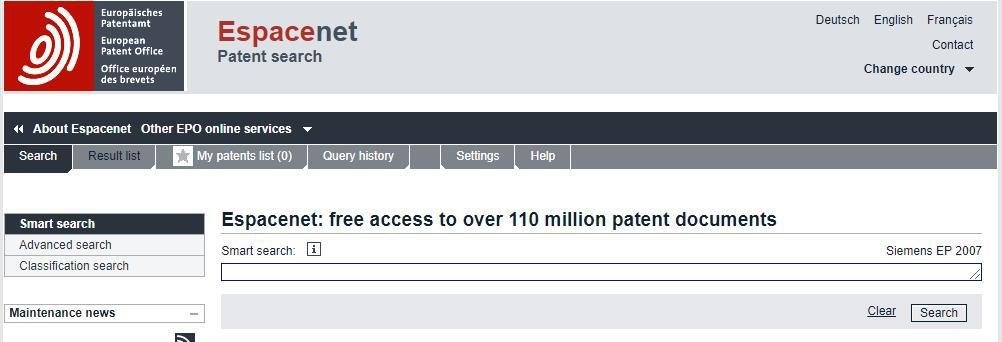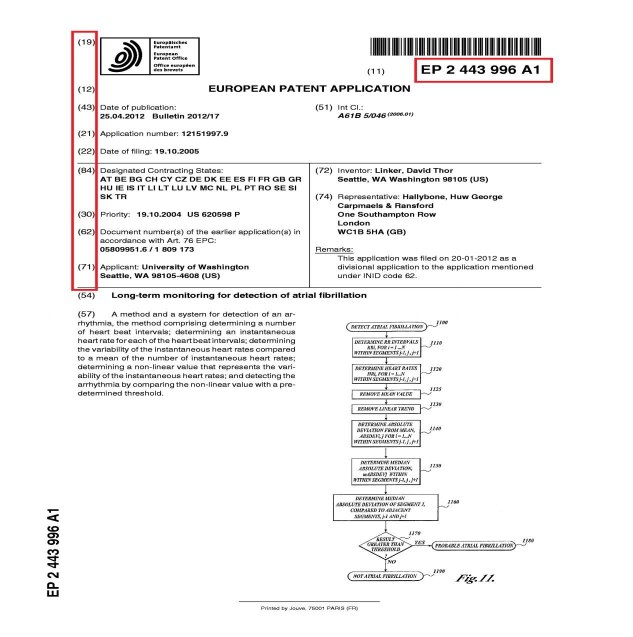
Patent specification refers to the collective name of various types of specifications published by national patent offices or international patent organizations. It is the main body of patent documents, including application specifications that have not undergone patentability examination, and patent specifications that have undergone patentability examination. The main function of a patent specification is to disclose new technical information and determine the scope of legal protection. In the patent specification, users can get all the technical information of the patent application and accurate legal information on the scope of patent protection.
How to read U.S.patents
► Introduction to the Content Composition of a US Patent
Usually the content of American invention patent is divided into four parts: Front Page, Drawings, Specifications and Claims.
1. The Front Page mainly introduces the basic data of the patent, such as patent application date, patent number, inventor's name, etc, and the abstract of the invention;
2. The drawings section contains the icon describing the invention;
3. Specifications describe the invention in writing;
4. Claims shall define the scope of protection of the patent.
The following content is illustrated in detail with the illustration in the patent document.
► Front Page
Cover mainly offer the basic information for the purpose, each basic data are marked in the upper left corner with the number of INID codes (Internationally agreed Numbers for the Identification of Bibliographic Data code; INID code). Each INID code represents different type of data. In the following content, we will introduces the connotation of several INID codes which we commonly used:
(12) textual interpretation of literature types
(54) name of the invention
(71) name of applicant
(72) name of inventor
(73) name of the recipient, holder or legal successor of the protected document
(21) application number
(22) application date
(63) the date and application number of the earlier application, and the current document is the continuation of the application
(51) international classification of patents or international classification of industrial designs
(52) internal classification or country classification
(58) search scope: refers to the United States patent classification number searched by the patent examiner when reviewing this patent
(10) literature marks
(45) the date of printing or similar publication of the authorized patent document on or before this date
(56) a separate list of comparative literature
For other INID codes and the types of information they represent, please refer to the introduction of INID codes by the USPTO:https://www.uspto.gov/web/offices/pac/mpep/s901.html#d0e112030
A brief description of the invention in extremely short words is also included on the cover. The number of claims and illustrations included in the patent will also be indicated below the summary. In addition, the cover may include drawings of the patent.
U.S. patent law explicitly requires the applicant to provide an illustration of the subject matter of the application to the extent necessary, which contains an icon depicting the invention. Some diagrams will be numbered for different components to facilitate the description in the text section. The following illustration illustrates a patent filed by Apple company for a display screen or portion thereof with graphical user interface.
In addition, in American patents, the graphical representation of learned technology indicates Prior Art, whereas the graphical representation without Prior Art indicates invention. Readers can often understand the characteristics of invention by comparing the graphical representation of learned technology and new invention.
At the top of the representative chart, words indicate how many patents have been applied and how many charts does it have. As shown in the following figure, there are one claim and one drawing sheet in this patent, which means there are one patent application scope and one chart in this patent.
► Specifications
The Specifications describes the invention in words, from which the reader can learn the background, motivation and details of the whole invention. The description and illustration of the invention are generally intended for those who are familiar with the art. The graphic design listed in this article is relatively simple, and the reader can read the Specification to get a general idea of the design intention.
► Claims
The scope of application for a patent, also known as a claim, defines the scope of protection of the patent. It is a simple description of the invention, the purpose of which is to make the reader quickly understand the outline of the invention in a short text.
► Reference and website
1.USPTO. Introduction to the INID code by the United States patent and trademark office. Retrieved from https://www.uspto.gov/web/offices/pac/mpep/s901.html#d0e112030
2.謝寶煖(2007)。解讀美國專利說明書。Retrieved from https://www.lis.ntu.edu.tw/~pnhsieh/epapers/no39.htm
3.如何閱讀美國專利?哈今的專利自學手冊。Retrieved from http://www.patent-tutorial.net/website/node/1102
4.專利-讀懂美國專利文獻。Retrieved from http://book.lib.ksu.edu.tw/blog/1482/%E5%B0%88%E5%88%A9%EF%BC%8D%E8%AE%80%E6%87%82%E7%BE%8E%E5%9C%8B%E5%B0%88%E5%88%A9%E6%96%87%E7%8D%BB
5. INID代碼。Retrieved from https://baike.baidu.com/item/INID%E4%BB%A3%E7%A0%81/17508870
Written by: Stella Gao
Master Student of civil law and intellectual property law, Faculty of Law, University of Macau
如何看懂中國專利?
一、中國專利基本概況
1.專利種類
中國專利共分為三種,分別為發明、實用新型和外觀設計。發明,是指對產品、方法或者其改進所提出的新的技術方案。實用新型,是指對產品的形狀、構造或者其結合所提出的適於實用的新的技術方案。外觀設計,是指對產品的形狀、圖案或者其結合以及色彩與形狀、圖案的結合所作出的富有美感並適於工業應用的新設計。[ 《中華人民共和國專利法》第二條第二、三、四款。]
2.專利文獻
專利文獻是記載專利申請、審査、批準過程中所產生的各種有關文件的文件資料。狹義的專利文獻指包括專利請求書、說明書、權利要求書、摘要在內的專利申請說明書和已經批準的專利說明書的文件資料。廣義的專利文獻還包括專利公報、專利文摘,以及各種索引與供檢索用的工具書等專利文獻是壹種集技術、經濟、法律三種情報為壹體的文件資料。
所謂如何看懂中國專利,即為如何看懂中國的專利文獻。本文所指的專利文獻為狹義的專利文獻。因專利說明書為中國知識產權局官方文件,所以本文主要以專利說明書為主要介紹對象。
二、專利說明書基本結構
專利說明書屬於壹種專利文件,是指含有扉頁、權利要求書、說明書等組成部分的用以描述發明創造內容和限定專利保護範圍的壹種官方文件或其出版物。
專利說明書中的扉頁是揭示每件專利的基本信息的文件部分。扉頁揭示的基本專利信息包括:專利申請的時間、申請的號碼、申請人或專利權人、發明人、發明創造名稱、發明創造簡要介紹及主圖(機械圖、電路圖、化學結構式等——如果有的話)、發明所屬技術領域分類號、公布或授權的時間、文獻號、出版專利文件的國家機構等。
權利要求書是專利文件中限定專利保護範圍的文件部分。權利要求書中至少有壹項獨立權利要求,還可以有從屬權利要求。
說明書是清楚完整地描述發明創造的技術內容的文件部分,附圖則用於對說明書文字部分的補充。中國的專利說明書部分包括:技術領域,背景技術,發明內容,附圖說明,實例等。
若使用者恰當使用相關數據庫進行檢索、比對、分析等,或者有些機構出版的專利說明書,還會附有檢索報告。檢索報告是通過對專利申請所涉及的發明創造進行現有技術檢索,找到可進行專利性對比的文件,向專利申請人及公眾展示檢索結果的壹種文件。附有檢索報告的專利文件均為申請公布說明書,即未經審查尚未授予專利權的專利文件。檢索報告以表格式報告書的形式出版。
中國專利說明書壹般由三部分組成:
1、著錄項目。包括專利號、專利申請號、申請日期、公布日期、專利分類號、發明題目、專利摘要或專利權範圍、法律上有關聯的文件、專利申請人、專利發明人、專利權所有者等。專利說明書的著錄項目較多並且整齊劃壹,每個著錄事項前還須標有國際通用的數據識別代號(INID)。
2、發明說明書。是申請人對發明技術背景、發明內容以及發明實施方式的說明,通常還附有插圖。旨在讓同壹技術領域的技術人員能依據說明重現該發明。
3、專利權項(簡稱權項,又稱權利要求書)。是專利申請人要求專利局對其發明給予法律保護的項目,當專利批準後,權項具有直接的法律作用。
下文針對專利文獻號、INID代碼、法律狀態進行詳細說明。
三、專利文獻號
依據《中華人民共和國知識產權行業標準 中國專利文獻號(ZC 0007—2012代替ZC 0007—2004)》,專利文獻號用9位阿拉伯數字表示,包括申請種類號和文獻流水號兩個部分。
專利文獻號中的第1位數字表示申請種類號,第2~9位數字(共8位)為文獻流水號,表示文獻公布或公告的排列順序。
1、申請種類號
專利文獻號中的申請種類號用1位阿拉伯數字表示。所使用的數字含義規定如下:1表示發明專利申請;2表示實用新型專利申請;3表示外觀設計專利申請。
上述申請種類號中未包含的其他阿拉伯數字在作為種類號使用時的含義由國家知識產權局另行規定。
2、文獻流水號
專利文獻號的流水號用8位連續阿拉伯數字表示,按照發明專利申請第壹次公布,或實用新型、外觀設計申請第壹次公告各自不同的編號序列順序遞增。
專利文獻號圖示:
四、INID代碼
依據《中華人民共和國知識產權行業標準 中國專利文獻著錄項目(ZC 0009—2012代替ZC 0009—2006)》,INID代碼是專利文獻著錄項目的識別代碼。Internationally agreed Numbers for the Identification of (bibliographic)Data的縮略語。
以“0”結尾的INID組別代碼指定用於以下情形:
當國家代碼/專利文獻號/專利文獻種類代碼聯用並同處壹行時,使用專利文獻標識的組別代碼(10);當作為優先權基礎的在先申請的申請號/申請日/申請受理國或組織聯用並同處壹行時,使用優先權數據組別代碼(30)。
以發明、實用新型專利文獻INID相關規範為例:
發明、實用新型專利文獻著錄項目名稱及相應INID代碼
(10)專利文獻標識
(12)專利文獻名稱
(15)專利文獻更正數據
(19)公布或公告專利文獻的國家機構名稱
(21)申請號
(22)申請日
(30)優先權數據
(43)申請公布日
(45)授權公告日
(48)更正文獻出版日
(51)國際專利分類
(54)發明或實用新型名稱
(56)對比文件
(57)摘要
(62)分案原申請數據
(66)本國優先權數據
(71)申請人
(72)發明人
(73)專利權人
(74)專利代理機構及代理人
(83)生物保藏信息
(85)PCT國際申請進入國家階段日
(86)PCT國際申請的申請數據
(87)PCT國際申請的公布數據
五、法律狀態
在檢索系統中檢索出專利相關文件時,左下角有關於“法律狀態”的查看窗口。
法律狀態及事務公告代碼的內容、規範和說明如下:
依據《中華人民共和國知識產權行業標準 專利文獻數據規範(ZC 0014—2012)》,法律狀態及事務公告共分為27個大類。
對於自成壹個大類且不包含小類的法律狀態或事務公告,用最能體現其特征的兩位大寫英文字母縮寫表示。
示例:
實質審查的生效,其代碼為SE。
對於屬於大類中的某壹小類的法律狀態或事務公告,其代碼由最能體現其大類特征的壹位大寫英文字母,加上最能體現其小類特征的壹位大寫英文字母構成;
示例:
專利權的全部(或部分)無效宣告,該大類下又包括兩個小類:
——全部無效,其代碼為IW;
——部分無效,其代碼為IP。
撰文:澳門大學法學院民法與知識產權法碩士研究生 蒋磊
Before we read the European Patent Literature, we need access to the EPO search site. We can go directly to the https://worldwide.espacenet.com/,or Link to the http://www.cnipa.gov.cn/gzjxglj/xgljgwzyzscqwz/ via the State Intellectual Property Office's foreign page.
The European patent database offers three types of search,1.SMART SEARCH, ,2.ADVANCED SEARCH, ,3.CLASSIFICATION SEARCH

► SMART SEARCH
The smart search box lets you enter word or multi-word searches, or more complex search commands. All you have to do is type one or more words that describe the invention patent you are looking for, and then click search. Or you can enter the number of the patent file, the inventor, the name of the company, or the date or year of the patent file.
► ADVANCED SEARCH
If you want to combine various search terms, you can use advanced search. For example, you can search for patent documents from a particular year and country that have specific words in the title or abstract.
► CLASSIFICATION SEARCH
Classification search is the option to use if you are interested in finding all the patent publications in a particular technical area – a powerful tool used by professional patent searchers, it can take a bit of time to get used to.
There is no patent application for utility model in the type of patent application in Europe. Therefore in Europe can only apply for invention and design patents, the European Union design patent is directly to the European Union Intellectual Property Office, so this article mainly introduces the European invention patent application documents read.
The invention patent specification refers to an official document containing the components of the title page, the claims, the specification, etc., which are used to describe the content of the invention and to define the scope of patent protection.
When we are reading the literature, we will first notice the document number below the bar code. As shown in the figure below, we can find that each data has a code before it, and each code is different. The EU document number is composed of country code (EP) + various document serial numbers + document kind codes, and the specific meaning of the document kind codes will be attached below the icon①.
When we look closely at the contents of the literature, we will find that there is a code in front of each bibliographic data. These codes are referred to as Internationally agreed Numbers for the Identification of Data code (INID code), which is for the convenience of different languages. Codes that can be inter worked by patent advisory. The meaning of the INID code is described below.②。

① Document kind codes:
A1 European patent application published with European search report
A2 European patent application published without European search report (search report not available at publication date)
A3 Separate publication of European search report
A4 Supplementary search report
A8 Corrected title page of A document, ie. A1 or A2 document
A9 Complete reprint of A document, ie. A1, A2 or A3 document.
B1 European patent specification (granted patent)
B2 New European patent specification (amended specification after opposition procedure)
B3 European patent specification (after limitation procedure)
B8 Corrected title page of B document (i.e. B1 or B2 document)
B9 Complete reprint of B document (i.e. B1 or B2 document)
②INID Code:
(10)Identification of the patent, SPC or patent document
(20)Data concerning the application for a patent or SPC
(30)Data relating to priority under the Paris Convention or the Agreement on Trade-Related Aspects of Intellectual Property Rights (TRIPS Agreement)
(40)Date(s) of making available to the public
(50)Technical information
(60)References to other legally or procedurally related domestic or previously domestic patent documents including unpublished applications therefor
(70)Identification of parties concerned with the patent or SPC
(80)(90)Identification of data related to International Conventions other than the Paris Convention, and to legislation with respect to SPCs
(21)Number(s) assigned to the application(s)
(22)Date(s) of filing the application(s)
(31)Number(s) assigned to priority application(s)
(32)Date(s) of filing of priority application(s)
(45)Date of making available to the public by printing or similar process of a patent document on which grant has taken place on or before the said date
(51)International Patent Classification or, in the case of a design patent, as referred to in subparagraph 4(c)of this Recommendation, International Classification for Industrial Designs
(54)Title of the invention
(57)Abstract or claim
(71)Name(s) of applicant(s)
(72)Name(s) of inventor(s) if known to be such
(74)Name(s) of attorney(s) or agent(s)
► Reference and website
Written by:Wang Jiamiao
Master Student of international law, Faculty of Law, University of Macau
How to read WIPO patents
► What does patent information cover?
Patent information comprises all information which has either been published in a patent document or can be derived from analyzing patent statistics. It includes:
Patents protect inventions for a specific period of time – generally no more than 20 years – and only in a specific country or a group of countries. Patents are published after a specific time – usually 18 months after filing – disclosing all the technical details of the invention. More particularly, the information in a patent document refers to the following:
Applicant: the name of the individual or company applying to have a particular technology protected;
Inventor: the name of the person or persons who invented and developed the invention;
Description: a clear and concise explanation of known existing technologies and problems associated with them and how the new technology is applied to solve these problems; specific examples of the new technology are also usually given;
Claims: a statement defining the scope of the protection sought or granted through the patent;
Citation and references: certain patent documents also include references to related technology information uncovered by the applicant or by a patent examiner during the patent granting procedure; these references and citations include both patent and non-patent documents.

The information contained in patent documentation can be aggregated to provide statistics on levels of patenting activity within or between countries and regions. Patent documents contain information in all fields of technology. The following search criteria can facilitate an effective technology search:
> publication number WO2003/071888
> application number PCT/US2003/003327
> priority numbers 60/358,607 US and 10/245,919 US
> filing date of 05.02.2003
> publication date of 04.09.2003

Written by: JIANG LEI
Master Student of Civil Law and Intellectual Property Law, Faculty of Law, University of Macau
What is a Patent?
Why researchers should care about patents?